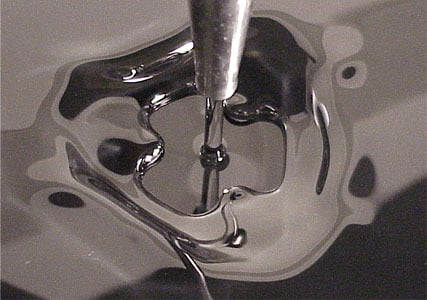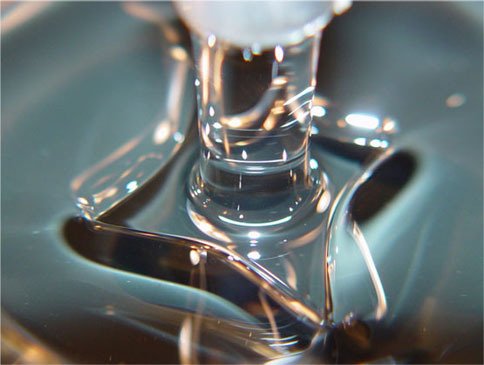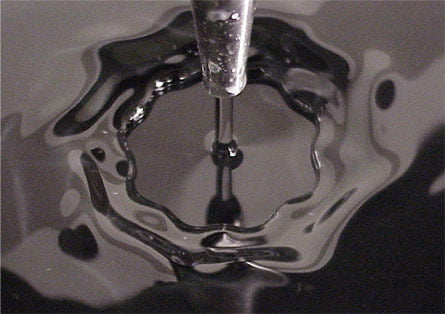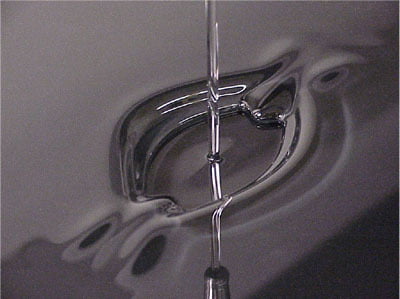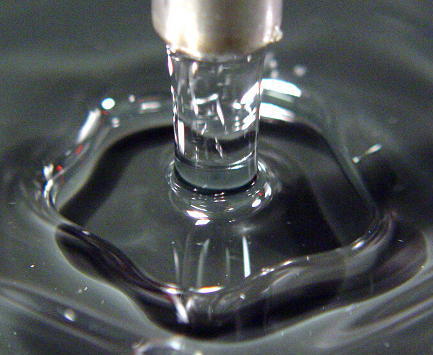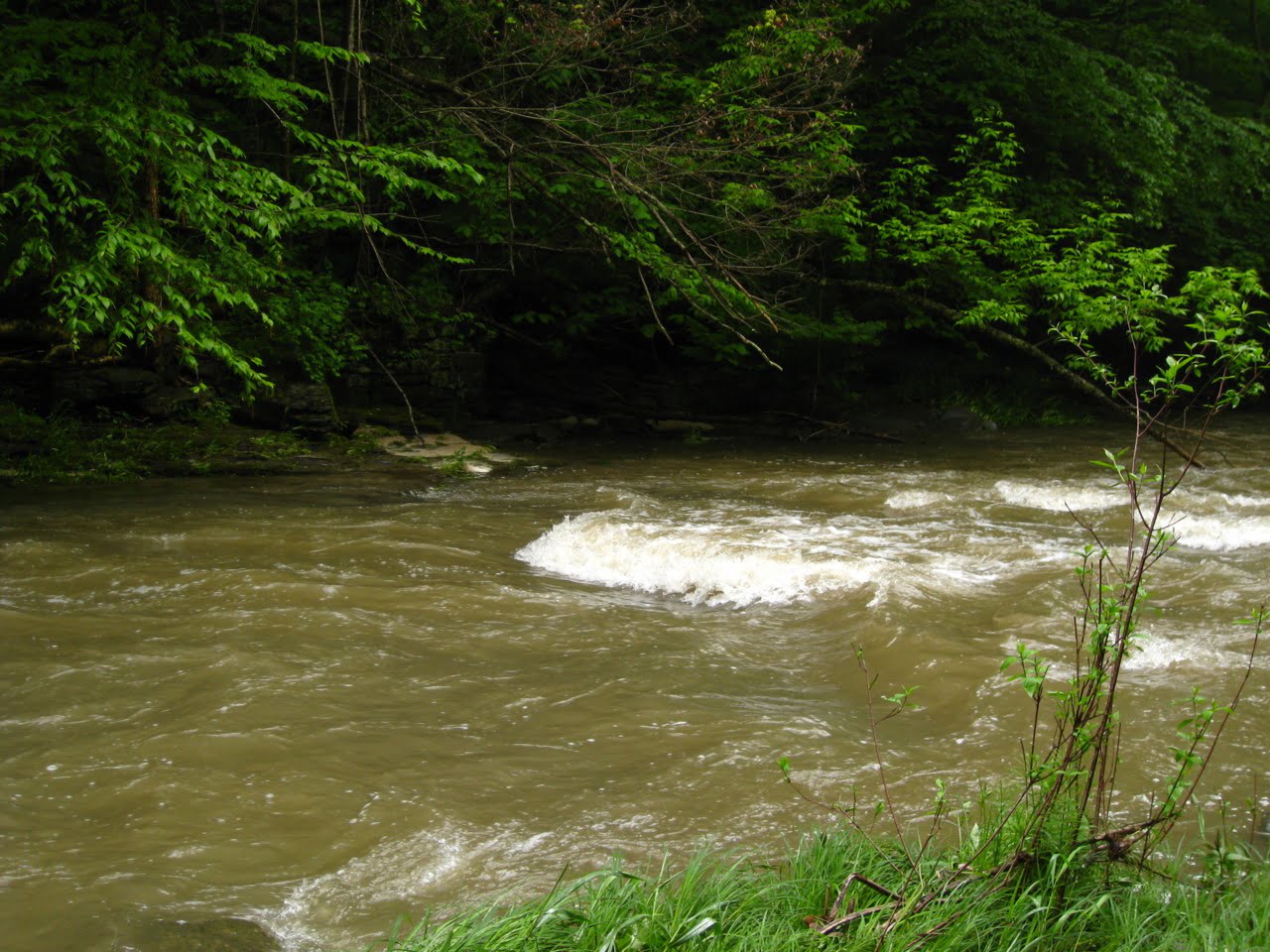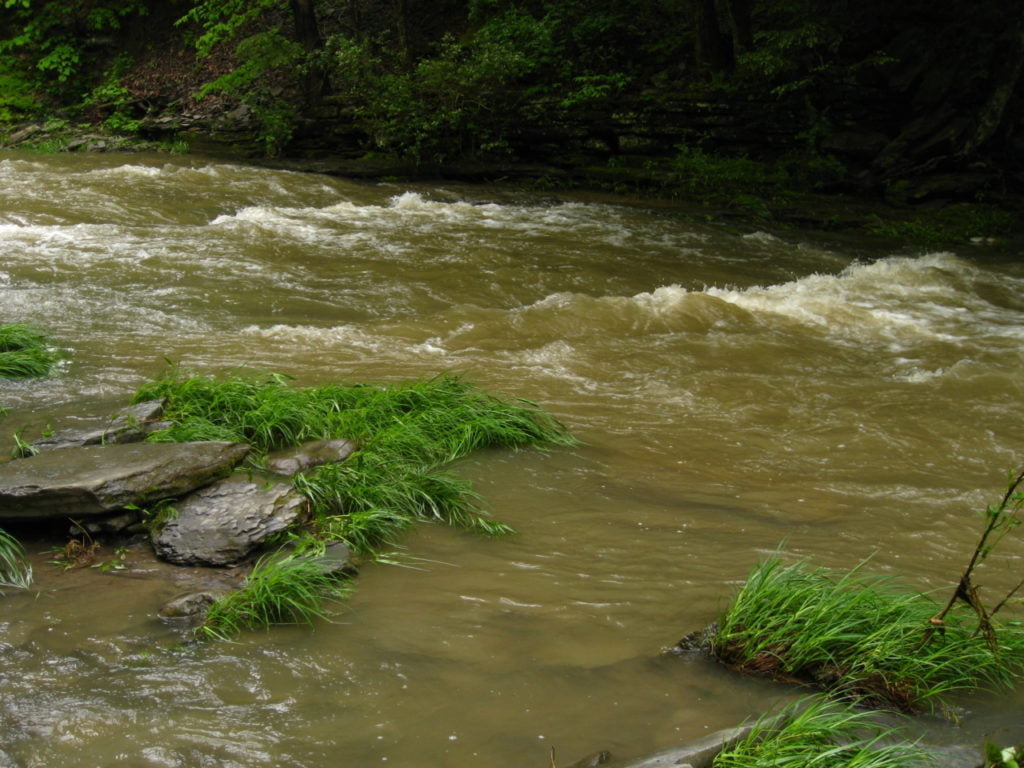If you’ve ever noticed the circular jump in your kitchen sink when you turn on the faucet, you’re familiar with what a jet does when it plunges into a horizontal layer of liquid. If the liquid is deep enough, the jet will perturb the surface into a circular depression, as in Figure (a) above. As the flow rate increases, a recirculating vortex ring and hydraulic bump forms (Figure b photo and flow schematic). At a critical flow rate, the bump will become unstable and form polygons instead of circles. At even larger flow rates, the system will shift toward a hydraulic jump, with a larger change in fluid elevation. Like bumps, these jumps can also appear in a variety of shapes. (Image credit: M. Labousse and J. W. M. Bush)
Tag: hydraulic jump

A Colorful Rinse
In this image a jet of water (clear/white) is rinsing a solution of polyacrylamide (PAM; blue) off a silicon surface. In the center, a hydraulic jump marks the interface where fast-moving laminar flow changes to a slower turbulent one. At the same time, the water, which is less viscous than the PAM, creates viscous finger-like protrusions into the blue liquid as it rinses the surface clean. (Photo credit: T. Walker, T. Hsu, and G. Fuller)

Polygonal Jumps
Hydraulic jumps occur when a fast-moving fluid enters a region of slow-moving fluid and transfers its kinetic energy into potential energy by increasing its elevation. For a steady falling jet, this usually causes the formation of a circular hydraulic jump–that distinctive ring you see in the bottom of your kitchen sink. But circles aren’t the only shape a hydraulic jump can take, particularly in more viscous fluids than water. In these fluids, surface tension instabilities can break the symmetry of the hydraulic jump, leading to an array of polygonal and clover-like shapes. (Photo credits: J. W. M. Bush et al.)

Hydraulic Jumps
This student video outlines the principles and mathematics behind the hydraulic jump, a commonly occurring phenomenon that occurs when a high velocity liquid flows into a low velocity zone. In order to slow down, the liquid’s kinetic energy converts to potential energy, resulting in an increase in height. Though often seen in kitchen sinks or rivers, the principle is also commonly used in dams and other manmade structures to control erosion of surrounding features. (Video credit: T. Price, D. Alexander, A. Rodabough, and D. Jensen)

How Dams Affect Rivers
This video shows how the installation of a dam can affect river flow and sediment transport. Before the dam is added, the flow is shallow and the sediment transport is uniform. The installation of the dam creates deep subcritical flow upstream and supercritical flow downstream. This means that wave information–like ripples–can propagate upstream on the subcritical side; on the supercritical side, the wave velocity is lower than the flow velocity and ripples cannot propagate upstream. This is analogous to sub- and supersonic flow in air. The critical flow over the dam is analogous to a shock wave. The lower velocity upstream of the dam is unable to carry sediment downstream and transport essentially ceases until the sediment builds up to a height where the depth of the water above the dam is roughly equal to that below the dam and sediment transport resumes, scouring the downstream supercritical section. Around 0:40, a gate is closed on the downstream side (off frame), creating a hydraulic jump. In the final section of the video, after sediment has built up on both sides of the dam, the downstream gate is re-opened and the jump reforms as sediment is blown out below the dam. (Video credit: Little River Research and Design, with funding from the Missouri Department of Natural Resources)

Voyager Explores the Edge of the Solar System
Though unconventional by our terrestrial concepts of fluids, the solar wind and its interaction with objects in and around our solar system can be considered a form of fluid dynamics. This NASA video discusses discoveries made by the Voyager spacecrafts as they leave our solar system and pass into interstellar space. The solar wind, a rarefied stream of charged particles, streams outward from the Sun at supersonic speeds. Eventually, the pressure from the interstellar medium surrounding the solar system is sufficient to slow the solar wind to subsonic speeds, causing a termination shock much like the hydraulic jump that forms in a kitchen sink when you turn the faucet on.

River Jumps

Hydraulic jumps occur when a high velocity liquid runs into an area of low velocity liquid. The faster moving liquid decelerates rapidly and increases in height, effectively trading kinetic energy for potential energy. The phenomenon is frequently observed in open channel flow, like in spillways or along rivers, as in the photos above. In nature, the hydraulic jump will often be laminar upstream and turbulent downstream. #

White Hole Analogues
A white hole–the cosmological opposite of a black hole–is a singularity from which matter emerges but which matter can never enter from beyond the event horizon. Hydraulic jumps, those rings that sometimes appear in the kitchen sink, turn out to be a physical analog of this behavior. The photo above shows a hydraulic jump with a needle placed inside the event horizon. In the wake of a needle, there’s a Mach cone, just like when an object moves faster than the speed of sound. For more, see the Photonist. (via freshphotons)
Note that we mentioned this item a few months ago, but the full paper has just been published.

The White Hole in Your Sink
Ever notice the distinctive ring that forms in your kitchen sink when you turn the water on? This phenomenon is known as a hydraulic jump; it occurs when a fast moving fluid (the water just discharged from the faucet) runs into a slow moving fluid (the water that’s been sitting in the sink) and transfers some of its kinetic energy into potential energy by increasing its elevation. Researchers have recently shown that this everyday occurrence is actually a physical analog to a white hole, the cosmological inverse of a black hole. (In theory, a white hole cannot be entered, but light and matter can escape it.) Check out Wired’s article for an explanation of the clever experiment that showed the equivalence of the two. #


